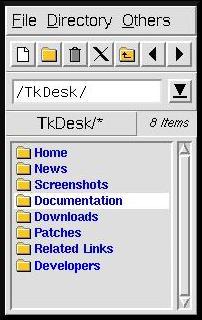Next
Previous
Contents
TkDesk is a graphical desktop manager for UNIX (with a slight emphasis
on Linux, but it also runs just as well on AIX, Solaris, HP-UX, SGI
Irix and other UNIX flavors) and the X
Window System. It offers a very
complete set of file operations and services, plus gives the user
the ability to configure most aspects of TkDesk in a very powerful
way. The reason for this is the use of the Tcl scripting language
as the configuration and
(for the greatest part of TkDesk) implementation
language. This makes TkDesk not just configurable but truly
programmable.
TkDesk has been influenced by various other systems and file
managers: NeXT, for laying out the file browser windows,
Apple Finder, for the idea of file annotations and, (shock horror),
Windows 95, for some other (of course minor and unimportant)
inspirations.
This is a brief overview of the most prominent features of TkDesk:
- Arbitrary number of automatically refreshed file browsers and
file list windows,
- Configurable file-specific popup-menus,
- Drag and drop,
- Files and directories may also be dropped onto the root window,
a.k.a. desktop,
- Configurable application bar, with several displays and
cascaded popup menus for
each button, files can also be dropped here,
- History of visited directories, opened files, executed commands,
and others, which is automatically saved to disk,
- Find files through their annotation, name, contents, size, age,
or other criteria,
- A trash can for safe deletion of files and directories,
- Calculation of disk usage for directory hierarchies,
- All file operations (find, copy, disk usage, etc.) are carried out in
the background,
- Traversal of directory hierarchies through recursive cascaded menus,
- Bookmarks, create menu entries for often used files/directories,
- Comprehensive hypertextish online help,
- Built-in multi-buffer and undo-capable editor,
- Remote control of XEmacs,
- Close coupling with Netscape Navigator for displaying HTML files or
selected URLs,
- Sound support,
- Powerful on-the-fly configuration of nearly all aspect of TkDesk using
Tcl/Tk, this also allows the Tcl-literate to extend TkDesk in
arbitrary ways,
- Free of charge! But see the file
COPYING, or menu
entry Help/License for
information on usage and redistribution of TkDesk.
TkDesk uses a number of other freely available packages without which
TkDesk would not have been possible. I [Christian Bolik] would like to say
many thanks to the following people:
- Chris Sterritt for setting up and managing the first TkDesk mailing list,
- Alan V. Shackelford for seamlessly taking over the list next,
- Gerald Willman for making the current mailing list available at
majordomo@lists.stanford.edu,
- Ken Hornstein for his wonderful netscape-remote package,
- Ioi Kim Lan for making an XPM image reader for Tk available,
- George Howlett for his great BLT, of which parts are used by TkDesk,
- Michael McLennan for his massively useful
[incr tcl],
- John Ousterhout for Tcl/Tk, which is definitely the best thing
since sliced bread,
- Greg Hankins and Matt Welsh for putting together the most
wonderful linuxdoc-sgml package,
- and of course, Linus Torvalds whose Linux kind of changed my
life, really!
And a very big thank you to the growing TkDesk user community,
which provides me with a constant flow of bug reports (getting less
now :-)), suggestions for enhancements of TkDesk, and lots of
motivation and encouragement.
Special thanks to Chuck Robey for revising a previous version of
this guide.
If you check menu entry Options/Use Netscape for Help,
TkDesk will use that for displaying
this User's Guide on-line. Otherwise, to reduce overhead, TkDesk
uses its own help system. It features
hypertext links, context sensitivity (which is not yet fully utilised by
TkDesk) and full text search.
The help window consists of four areas:
- A listbox listing all the section headings. A section can be
selected by pressing the left mouse button,
- the text display, which contains the actual help text,
- a text entry field in which
a regular expression may be entered (such as
[Ff]eatures). After hitting Return, the whole help
text is searched for this expression. Pressing Return again
continues the search,
- three buttons: "Print" prints the complete help
volume, "Back" jumps back after a hypertext
link has been followed (see next paragraph), and "Close"
to close the help window.
Text that is displayed blue in the help window is a hypertext
link. When the left mouse button is clicked over such a link the
display will automatically change to the referenced section. You can
jump back by pressing the "Back" button described above.
The following keys are bound when the mouse pointer is inside the help
window:
TabMoves to the next section.
Shift-TabMoves to the previous section.
Control-TabMoves to the first section.
Control-Shift-TabMoves to the last section.
Up, DownScrolls one line up/down.
Page up, Page downScrolls one page up/down.
Control-HomeJumps to start of help text.
Control-EndJumps to end of help text.
Meta/Alt-bEquivalent to pressing the
"Back" button.
Meta/Alt-c, EscapeEquivalent to pressing the
"Close" button.
Usually TkDesk is started simply by executing the command
"tkdesk" from the shell prompt or your X
initialisation file. However, you may specify the following options
to this command:
- -configdir dir
Reads the configuration from
directory dir instead of ~/.tkdesk.
- -default
Reads the default configuration of TkDesk
instead of the user's one in ~/.tkdesk.
- -iconic
Iconifies all file browser and file list windows
created by TkDesk during start-up.
- -layout file
Reads the window layout information from
file file instead of the default ~/.tkdesk/_layout.
- -startdir dir
If this option is given,
the first file browser will open with directory dir.
- -twm
Don't use icon windows when file browser or list
windows are iconified. Some window managers liek twm cannot handle
these properly.
For example, the command "tkdesk -twm -iconic"
tells Tkdesk to not use icon windows and start with all windows iconified.
Next
Previous
Contents
|


